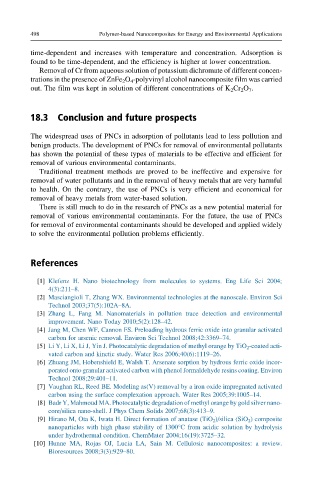Page 545 - Polymer-based Nanocomposites for Energy and Environmental Applications
P. 545
498 Polymer-based Nanocomposites for Energy and Environmental Applications
time-dependent and increases with temperature and concentration. Adsorption is
found to be time-dependent, and the efficiency is higher at lower concentration.
Removal of Cr from aqueous solution of potassium dichromate of different concen-
trations in the presence of ZnFe 2 O 4 -polyvinyl alcohol nanocomposite film was carried
out. The film was kept in solution of different concentrations of K 2 Cr 2 O 7 .
18.3 Conclusion and future prospects
The widespread uses of PNCs in adsorption of pollutants lead to less pollution and
benign products. The development of PNCs for removal of environmental pollutants
has shown the potential of these types of materials to be effective and efficient for
removal of various environmental contaminants.
Traditional treatment methods are proved to be ineffective and expensive for
removal of water pollutants and in the removal of heavy metals that are very harmful
to health. On the contrary, the use of PNCs is very efficient and economical for
removal of heavy metals from water-based solution.
There is still much to do in the research of PNCs as a new potential material for
removal of various environmental contaminants. For the future, the use of PNCs
for removal of environmental contaminants should be developed and applied widely
to solve the environmental pollution problems efficiently.
References
[1] Klefenz H. Nano biotechnology from molecules to systems. Eng Life Sci 2004;
4(3):211–8.
[2] Masciangioli T, Zhang WX. Environmental technologies at the nanoscale. Environ Sci
Technol 2003;37(5):102A–8A.
[3] Zhang L, Fang M. Nanomaterials in pollution trace detection and environmental
improvement. Nano Today 2010;5(2):128–42.
[4] Jang M, Chen WF, Cannon FS. Preloading hydrous ferric oxide into granular activated
carbon for arsenic removal. Environ Sci Technol 2008;42:3369–74.
[5] Li Y, Li X, Li J, Yin J. Photocatalytic degradation of methyl orange by TiO 2 -coated acti-
vated carbon and kinetic study. Water Res 2006;40(6):1119–26.
[6] Zhuang JM, Hobenshield E, Walsh T. Arsenate sorption by hydrous ferric oxide incor-
porated onto granular activated carbon with phenol formaldehyde resins coating. Environ
Technol 2008;29:401–11.
[7] Vaughan RL, Reed BE. Modeling as(V) removal by a iron oxide impregnated activated
carbon using the surface complexation approach. Water Res 2005;39:1005–14.
[8] Badr Y, Mahmoud MA. Photocatalytic degradation of methyl orange by gold silver nano-
core/silica nano-shell. J Phys Chem Solids 2007;68(3):413–9.
[9] Hirano M, Ota K, Iwata H. Direct formation of anatase (TiO 2 )/silica (SiO 2 ) composite
nanoparticles with high phase stability of 1300°C from acidic solution by hydrolysis
under hydrothermal condition. ChemMater 2004;16(19):3725–32.
[10] Hunne MA, Rojas OJ, Lucia LA, Sain M. Cellulosic nanocomposites: a review.
Bioresources 2008;3(3):929–80.

